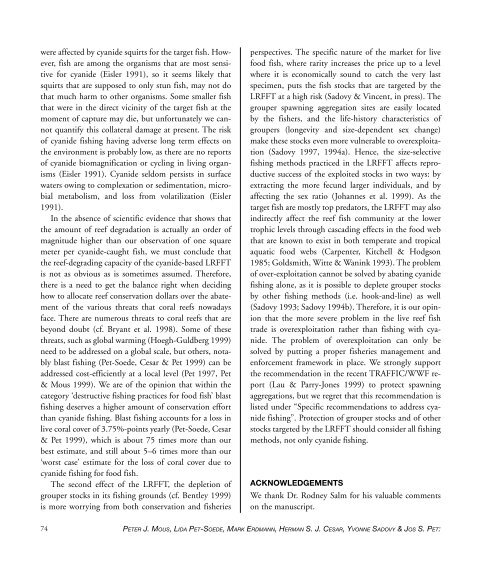You also want an ePaper? Increase the reach of your titles
YUMPU automatically turns print PDFs into web optimized ePapers that Google loves.
were affected by cyanide squirts for the target fish. However,<br />
fish are among the organisms that are most sensitive<br />
for cyanide (Eisler 1991), so it seems likely that<br />
squirts that are supposed to only stun fish, may not do<br />
that much harm to other organisms. Some smaller fish<br />
that were in the direct vicinity <strong>of</strong> the target fish at the<br />
moment <strong>of</strong> capture may die, but unfortunately we cannot<br />
quantify this collateral damage at present. The risk<br />
<strong>of</strong> cyanide fishing having adverse long term effects on<br />
the environment is probably low, as there are no reports<br />
<strong>of</strong> cyanide biomagnification or cycling in living organisms<br />
(Eisler 1991). Cyanide seldom persists in surface<br />
waters owing to complexation or sedimentation, microbial<br />
metabolism, and loss from volatilization (Eisler<br />
1991).<br />
In the absence <strong>of</strong> scientific evidence that shows that<br />
the amount <strong>of</strong> reef degradation is actually an order <strong>of</strong><br />
magnitude higher than our observation <strong>of</strong> one square<br />
meter per cyanide-caught fish, we must conclude that<br />
the reef-degrading capacity <strong>of</strong> the cyanide-based LRFFT<br />
is not as obvious as is sometimes assumed. Therefore,<br />
there is a need to get the balance right when deciding<br />
how to allocate reef conservation dollars over the abatement<br />
<strong>of</strong> the various threats that coral reefs nowadays<br />
face. There are numerous threats to coral reefs that are<br />
beyond doubt (cf. Bryant et al. 1998). Some <strong>of</strong> these<br />
threats, such as global warming (Hoegh-Guldberg 1999)<br />
need to be addressed on a global scale, but others, notably<br />
blast fishing (Pet-Soede, Cesar & Pet 1999) can be<br />
addressed cost-efficiently at a local level (Pet 1997, Pet<br />
& Mous 1999). We are <strong>of</strong> the opinion that within the<br />
category ‘destructive fishing practices for food fish’ blast<br />
fishing deserves a higher amount <strong>of</strong> conservation effort<br />
than cyanide fishing. Blast fishing accounts for a loss in<br />
live coral cover <strong>of</strong> 3.75%-points yearly (Pet-Soede, Cesar<br />
& Pet 1999), which is about 75 times more than our<br />
best estimate, and still about 5–6 times more than our<br />
‘worst case’ estimate for the loss <strong>of</strong> coral cover due to<br />
cyanide fishing for food fish.<br />
The second effect <strong>of</strong> the LRFFT, the depletion <strong>of</strong><br />
grouper stocks in its fishing grounds (cf. Bentley 1999)<br />
is more worrying from both conservation and fisheries<br />
perspectives. The specific nature <strong>of</strong> the market for live<br />
food fish, where rarity increases the price up to a level<br />
where it is economically sound to catch the very last<br />
specimen, puts the fish stocks that are targeted by the<br />
LRFFT at a high risk (Sadovy & Vincent, in press). The<br />
grouper spawning aggregation sites are easily located<br />
by the fishers, and the life-history characteristics <strong>of</strong><br />
groupers (longevity and size-dependent sex change)<br />
make these stocks even more vulnerable to overexploitation<br />
(Sadovy 1997, 1994a). Hence, the size-selective<br />
fishing methods practiced in the LRFFT affects reproductive<br />
success <strong>of</strong> the exploited stocks in two ways: by<br />
extracting the more fecund larger individuals, and by<br />
affecting the sex ratio (Johannes et al. 1999). As the<br />
target fish are mostly top predators, the LRFFT may also<br />
indirectly affect the reef fish community at the lower<br />
trophic levels through cascading effects in the food web<br />
that are known to exist in both temperate and tropical<br />
aquatic food webs (Carpenter, Kitchell & Hodgson<br />
1985; Goldsmith, Witte & Wanink 1993). The problem<br />
<strong>of</strong> over-exploitation cannot be solved by abating cyanide<br />
fishing alone, as it is possible to deplete grouper stocks<br />
by other fishing methods (i.e. hook-and-line) as well<br />
(Sadovy 1993; Sadovy 1994b). Therefore, it is our opinion<br />
that the more severe problem in the live reef fish<br />
trade is overexploitation rather than fishing with cyanide.<br />
The problem <strong>of</strong> overexploitation can only be<br />
solved by putting a proper fisheries management and<br />
enforcement framework in place. We strongly support<br />
the recommendation in the recent TRAFFIC/WWF report<br />
(Lau & Parry-Jones 1999) to protect spawning<br />
aggregations, but we regret that this recommendation is<br />
listed under “Specific recommendations to address cyanide<br />
fishing”. Protection <strong>of</strong> grouper stocks and <strong>of</strong> other<br />
stocks targeted by the LRFFT should consider all fishing<br />
methods, not only cyanide fishing.<br />
ACKNOWLEDGEMENTS<br />
We thank Dr. Rodney Salm for his valuable comments<br />
on the manuscript.<br />
74<br />
PETER J. MOUS, LIDA PET-SOEDE, MARK ERDMANN, HERMAN S. J. CESAR, YVONNE SADOVY & JOS S. PET:


















